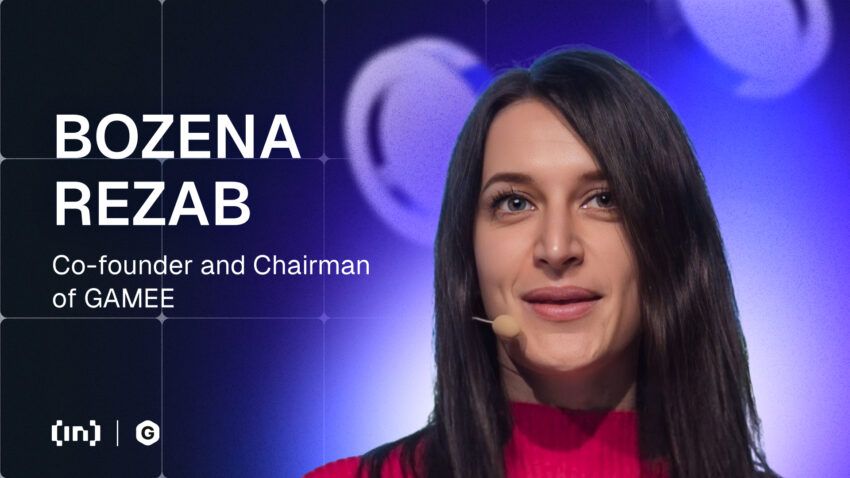Adding tokenized financial incentives to Web3 disrupts the traditional gaming model by attracting new players and retaining their participation through quality gameplay.
At Consensus Hong Kong, BeInCrypto spoke with Bozena Rezab, Chairperson and Co-Founder of GAMEE, about how gaming can be a powerful tool for onboarding new users to Web3 and how reward systems can be leveraged to capture different audiences.
Web3 Gaming Experiences Strong User Growth
Blockchain gaming has made strides in expanding user growth and engaging players from Web2 who have previously had no interaction with Web3 applications.
The sector grew remarkably despite facing a difficult macroeconomic environment in 2024, where gaming faced increased competition from new narratives such as meme coins and AI agents.

According to a report by DappRadar, blockchain gaming reached a high of 7.4 million daily Unique Active Wallets (dUAW) by Q3 2024, representing a 421% increase over the previous 12 months.
Much of this success can be attributed to gaming developers’ proactive approach to widen adoption across different platforms and develop strategies to preserve user attention.
Gaming as an Onboarding Tool
According to Rezab, blockchain gaming is one of the most frictionless methods the Web3 community can use to onboard new users, especially those with little to no knowledge of the industry.
“The first easy steps are for people to guide them through a game or something engaging to have a wallet and have their first crypto. That’s not as difficult, but then there’s DeFi, or there are different financial elements of crypto that are scary or complicated. So in games, I think we have a higher chance of offering people the first step” Rezab told BeInCrypto.
She also explained the importance of understanding the audience that you are trying to reach. Blockchain gaming can work across several platforms, whether part of Web2 or Web3.
GAMEE, for example, has experimented with this idea by distributing it across social media, including Facebook and Telegram, as well as lesser-known Viber and Kick.
By adapting the gaming product offered to the specific demand akin to the platform, GAMEE was able to reach new audiences.
“If you figure out product-wise, what’s the strength of the platform, then you can use it for the benefit of the game. How the sharing works, why people use the platform, how they use it, is it in groups or in channels? Is it more streaming? If you have something engaging that fits the strength of the platform, the distribution is very strong,” Rezab explained.
Once the player is introduced to the game, providing incentives to stay can help maintain their involvement in the long run.
Sharing Ad Revenue with Players
In December 2024, GAMEE launched AdNetwork to redesign how value generated by digital advertising is shared with advertisers and their audience.
“We were thinking about it also with our current knowledge of crypto and Web3 and obviously what comes to mind is, OK, there is a participant that provides the attention, has all the data as a player, and they get absolutely nothing from the advertising. So we were thinking about it with the lens of, ‘can we do that a bit differently and change the flow of the value directed to the player?” Rezab explained.
Under its new advertising network, GAMEE users are invited to engage with different adverts and benefit from their interaction. By completing tasks or viewing ads, users receive in-game rewards. This initiative is designed to expand the reach of tokenized advertising in the gaming sector.
“Let’s say there’s 2 billion impressions monthly on our properties. You can fractionalize or tokenize the impressions and you offer a fraction of the ad space to users. You have proof you own it, kind of like a certificate, because it’s on the blockchain and it gives you access to the revenue or the success of the game. This way, the users participate in the success of the platform and it’s also an interesting way for the platform to fundraise, or introduce new games, and create communities,” Rezab added.
Though users already have an incentive, developers must also ensure that the advert is interesting to stand out against the competition.
“Some principles remain unchanged. Advertising only works if it captures attention, so creativity and storytelling really matter. I don’t think that will change. The disruptive element here lies in the flow of value—if you can involve the person targeted by the ads in any way, whether through rewards or data usage permissions, that’s something blockchain brings,” Rezab said.
In the meantime, users can continue to earn rewards by directly engaging with the games themselves.
GameFi and the Power of Incentive-Based Participation
While GAMEE’s approach to advertising has shown an alternative to traditional funding methods that normally rely on venture capital investments, its incentive-based participation programs also reinvigorate player participation.
GameFi describes online gaming as leveraging some of the inherent characteristics of decentralized finance (DeFi). This model of blockchain gaming enables players to earn crypto rewards and assets while incentivizing developers to build in-game economies.
While traditional games require players to spend money, GameFi allows them to earn money through play-to-earn mechanisms. These can include collecting NFTs that represent in-game items such as characters or weapons, introducing DeFi protocols such as staking or liquidity pools, and collecting crypto rewards by completing tasks.
When GAMEE launched its WatBird game on the TON network, it offered crypto as a reward for users’ interaction with the game.
“When people claimed the token, I think it was around 7 million people eligible for the crypto—they earned it. There were no sales at all, so it was like a fully fair launch distributed to the community. It was amazing to see so many interacting with blockchain and crypto for the first time. You go from almost no experience to having 7 million people eligible to play for crypto for the first time,” Rezab said.
Though this innovative model has successfully onboarded millions of new users, it also contains a hidden flaw.
The Retention Challenge
Player retention is a balancing act. Developers must learn to weigh financial incentives and compelling gameplay equally to ensure that player participation remains durable over time.
If one aspect is prioritized over the other, the entire game design loses its sustainability.
“What we have observed so far is that when you have no incentive in the game whatsoever, you see the pure retention and engagement. When you add incentives to a game with good retention, it’s superb. If you add incentives and ownership on top of a retaining game, it’s unstoppable. However, if you add incentives to a poorly performing game, it tends to mask the game’s shortcomings and attract users you might not necessarily want. So, I would highly suggest testing games without incentives first to ensure they’re engaging enough, and then you can sweeten it up,” Rezab explained.
As Web3 gaming continues to evolve, integrating creative incentive models and engaging gameplay will pave the way for a future where blockchain technology seamlessly enhances the player experience.
Ultimately, this is likely the most effective means of driving mass adoption and reshaping the gaming sector.
Disclaimer
In compliance with the Trust Project guidelines, this opinion article presents the author’s perspective and may not necessarily reflect the views of BeInCrypto. BeInCrypto remains committed to transparent reporting and upholding the highest standards of journalism. Readers are advised to verify information independently and consult with a professional before making decisions based on this content. Please note that our Terms and Conditions, Privacy Policy, and Disclaimers have been updated.



